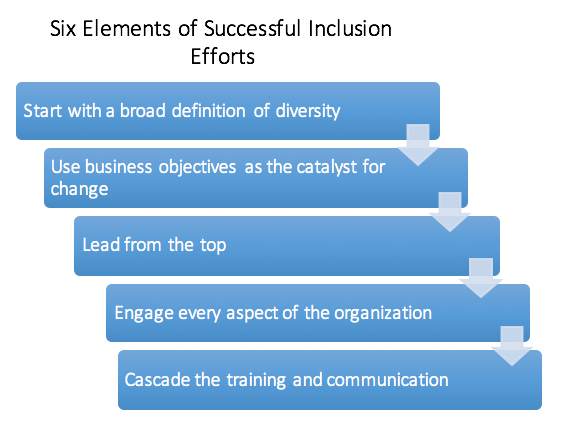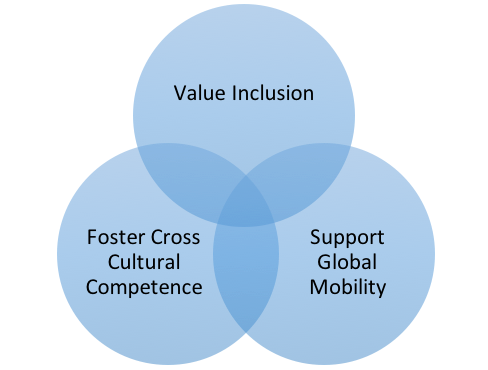Towards Inclusivity: A White Paper on Diversity Best Practices
The notion of diversity and its importance has been a mainstay of talent management for the last two decades. It is only recently, however, that it has evolved from an important initiative to a business imperative. Successful organizations connect the benefits of inclusion to their corporate performance. They benefit from greater employee engagement, a truly global leadership pipeline and the problem solving strength of multiple perspectives. Global organizations also benefit from better market insight and stronger connections to their communities.
The Case For Diversity At Company
By incorporating the elements of successful inclusion with the strategies to create an inclusive culture, Company can impact each of the seven tenets of its success. If individuals at Company recognize its diverse population as a unique asset, they can create strategies that leverage the immense collective potential and talent. Based on the experiences of other organizations, a well managed diversity and inclusion program can directly influence Company’s results in several key areas:
- Maximize the value of a global footprint- Companies as diverse as Royal Dutch Shell, Proctor and Gamble and AT&T all cite staying close to their global foot print as a key driver of their diversity initiatives. “The more the employees can reflect the consumers, the better we do as a company,” says Linda Clement-Holmes, Proctor &Gamble’s Chief Diversity Officer and Senior Vice President Global Business Services.
- Encourage collaborative innovation- 85% of respondents to a study sponsored by Forbes said that a diverse workforce was critical to their innovation efforts.
- Strive for operational excellence- A recent study by Society For Human Resource Management (SHRM) and The Economist Magazine found that 53% of survey respondents say that tapping a broader range of skills to promote efficiency is a business rationale for their diversity programs.
Key Elements Of Successful Diversity And Inclusion Programs
Valuing inclusion is far more than creating affinity groups in an organization: valuing is intentionally creating a culture where everyone has the opportunity to contribute. Inclusion can be an effective strategy to leverage all of an organization’s creativity and talent. To reap the benefits of a diverse workplace, however, inclusion must be a value that permeates the practices and policies throughout the business. To successfully create a culture of inclusion, organizations must engage individuals by meaningfully connecting them to the purpose and mission.
Our research of best practices across multiple industries has shown that while each company takes its own path, there are six common elements of successful inclusion programs.
Start with a Broad Definition of Diversity
There are many ways to define diversity. A traditional definition focuses on differences related to age, ethnicity, gender, and race. Organizations who subscribe to this definition of diversity support people of different backgrounds through programs that include education, affinity groups and other means of targeted engagement. However, these programs often fail to create a truly inclusive organization.
Best practice organizations use a broader definition of diversity. This is especially important in global organizations like Company where the notion of diversity should be broad enough to encompass the very real differences in culture that may exist in different locations across the globe. Using a wider view creates the potential to see diversity as an opportunity to learn from and engage others, leveraging multiple approaches to problem solving, creativity and innovation. Forward thinking organizations also incorporate the perspective of the included.
Inclusion is a sense of belonging: feeling respected, valued for who you are; feeling a level of supportive energy and commitment from others so than you can do your best work, (Miller and Katz 2002).
Use Business Objectives As A Catalyst For Change
Organizational change is hard, and organizational change that requires shifts in culture is harder even still. A key determinant of the success of organizational change is the commitment of stakeholders. Cultural changes that have strong connections to meaningful business objectives are able to achieve greater levels of commitment because more stakeholders are impacted by the benefits. For diversity initiatives to take hold, best practices suggest a strong link to organizational performance. Organizations as diverse as McKinsey and Company and US Army have recognized the benefits of diversity and inclusion, (McKinsey 2011; US Army 2010). In contrast, ignoring the impact or the existence of diversity limits an organization’s potential to flourish in today’s global economy.
|
Common Business Objectives And How They Are Supported By Inclusion |
|
|
Profitability |
Firms with higher levels of foreign and women executives boasted 53% higher return on equity than other companies. (A McKinsey & Company study, for instance, of 180 publicly-traded companies from 2008 to 2010) |
|
Innovation |
Bringing together workers with different qualifications, backgrounds, and experiences are all key to effective problem-solving on the job. Similarly, diversity breeds creativity and innovation. Of 321 large global enterprises-companies with at least $500 million in annual revenue-surveyed in a Forbes study in 2011, 85 percent agreed or strongly agreed that diversity is crucial to fostering innovation in the workplace. |
|
Increased engagement |
A 2004 study by the Conference Board found that a commitment to diversity is the one of the top 5 levers of engagement. Notably, the commitment to diversity was important to employees across race, ethnic and gender lines suggesting that each employee feels that diversity is an important factor in the workplace. |
Lead From The Top
Forward-thinking organizations realize that leaderships’ support of diversity programs is perceived as a reflection of the organization’s commitment and values. This is consistent with broader research on what makes culture change successful. A recent report by SHRM reveals two statistics that demonstrate the importance of top leadership support:
- 60% of todays corporate leaders are perceived as strong supporters of their organization’s diversity efforts
- 22% of corporate diversity officers cite lack of senior leadership support as their primary challenge
Leadership support can take many forms. Doug Conant, former CEO of Campbell Foods, suggests that corporate leaders drive diversity by being a visible part of the process. “I am a big believer in “being the change you want to see” in your organization, no matter whether you are a middle manager or a CEO. I began every staff and global leadership meeting with the topics of diversity and inclusion. I actively supported our human resources network groups and several novel ideas that came from the nooks and crannies of the organization”, (HBR 2011).
Engage every Level
As noted elsewhere in this document, best practice organizations support diversity and inclusion at the most senior levels of the organization. However, the programs work best when they are also supported by and implemented through line managers and others directly involved in operations (SHRM 2008). Leaving the implementation to line managers and other localized personnel recognizes the fact that inclusion can not be a one-size-fits-all solution.
Global inclusion programs must be comprehensive enough to generate real results and flexible enough to be relevant and operationally realistic in every location. A flexible approach to inclusion does not mean that parts of the organization can opt out. It does mean that leaders can localize programming, policies and procedures to build engagement and drive results.
Cascade the training and communication
Engaging at every level in an organization requires segmented training and communication that links the specific behaviors required in individual roles to an overarching strategy and performance standards. Company could use this approach to link inclusion and corporate performance goals.
To effectively drive culture change the training must target the gap between current levels of competency and skills required to sustain the change. The following courses are based on core set of skills but cascade specific messages from leader to individual contributor.
- Leader - Leading With A Global View
- Manager- Managing Global Teams
- Individual Contributor- Improving Relationships Across The Globe
Strategies to Build Inclusion
Many organizations recognize the importance of inclusion but struggle to create a program that takes hold. To succeed, organizations must be intentional about the culture they want to create. Strategies to create an inclusive culture include:
- Value inclusion and diversity
- Foster cross cultural competence
- Support global mobility
Value inclusion
Valuing diversity and inclusion goes beyond mission statements and platitudes. Best practice organizations have intentional policies and processes that promote diverse talents and voices. They recognize that inclusion requires efforts by the organization as well as by individuals.
Best Practice- Procter & Gamble
Procter & Gamble has been in the top ten of Diversity Magazines Top 50 Companies list for the last 12 years. They believe that inclusion is at the core of their strategy and critical to their success. It is how they stay close to global markets and helps with innovation and talent acquisition. According to William Gipson Chief Diversity Officer and Senior Vice President, Research & Development, winning with diverse customers requires an inclusive culture.
“I have experienced the power of diversity, where diverse teams of employees have delivered breakthrough results for the Company, with innovative products that win with all consumers. And it all starts with winning with our own employees through an inclusive culture where everyone feels valued and included and importantly, able to perform at their peak every day.”
Worth noting...
- The position of Chief Diversity Officer rotates among senior executives ensuring that diversity strategies have a strong tie to operations and new perspectives are continually incorporated
- To help retain high potential women, they have created a program of personalized work schedules so that work can fit around life not the other way around



